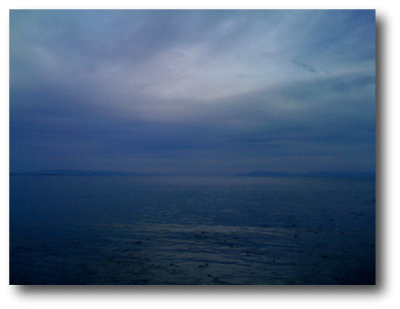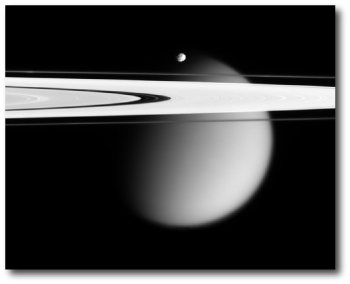
Without regard to order of likelihood, I thought it’d be interesting to lay out a few very specific scenarios by which the first extrasolar world with a 1 million+ habitability valuation could be discovered.
A favorite space-art trope is the habitable moon orbiting the giant planet (which is generally well-endowed with an impressive ring system). Smoggy frigid Titan is the best our solar system can do along these lines, but there’s nothing preventing better opportunities for habitability lying further afield.
I’ve always been intrigued by the fact that the regular satellite systems of the solar system giants each contain of order 2 parts in 10,000 of the mass of the parent planet. At present, there’s no reason to expect that this scaling is any different for extrasolar planets, and given the example of Titan, there doesn’t seem to be anything to prevent the bulk of a given planet’s satellite mass from being tied up in a single large body. Furthermore, since it’s my weblog, I’ll take the liberty of assuming that the satellite mass fraction scales with stellar metallicity.

Image source.
It’s perfectly reasonable to imagine, then, that HD 28185b is accompanied by a 0.63 M_earth, 0.86 R_earth satellite with an orbital radius of a million kilometers. HD 28185b itself has Msin(i)=5.7 Mjup, and the metallicity of HD 28185 is [Fe/H]=+0.24.
Now, for a long shot: let’s assume that on July 11th, 2009, a cadre of small telescope observers in Australia, South Africa and South America discover that HD 28185b transits its parent star. The geometric a-priori odds of the transit are ~0.5%. The expected transit depth is an eminently detectable 1%. A transit of moderate impact parameter lasts about 12 hours.
If a detection is made on July 11th, 2009, it’s a sure thing that the following transit (July 29th, 2010) will be the subject of great scrutiny. The current ground-based state of the art using orthogonal transfer arrays is demonstrating 0.4 mmag photometry with 80 second cadence. At this level, with spot filters and several observatory-class telescopes participating, the piggyback detection of the satellite transit is a many-sigma detection.The cake would be iced on Aug 16th, 2011, when the ~25 second difference in midpoint-to-midpoint intervals would be detected. We’d then be in possession of a potentially habitable terrestrial world warmed by an admirably bright and nearby parent star. Accurate mass and radius determinations would be fully forthcoming. All from the ground, and all at a total cost measured in thousands of dollars of amortized telescope time on existing facilities.
Admittedly, the odds of this specific scenario are slim. I estimate one in two thousand. The payoff, however, is massive. HD 28185bb (with the properties given above) is worth a staggering 100 million dollars. In expectation, then, that’s 50,000 dollars for fully covering the transit window this July…

Every space art rendering of that planet seems to give it an Earthlike moon. One of these days I’m going to have to do a rendering of HD 28185b being orbited by a bunch of small airless rockballs just for the sheer perversity factor.
And while I’m at it, not giving it a ring system either.
Pingback: Astrodicticum Simplex
Hi Greg & andy
I’d love to see such a habitable-moon primary gas giant covered in water clouds with a nice sulfurous yellow band around its belly, just for something different – an atmosphere with a more realistic composition for a gas giant so close to its star. All the ammonia and most of the methane would surely have been photolysed away by the star or pyrolysed in the super-Jovian’s still fiery depths.
qraal: not sure about that. Could well be Sudarsky type 3 because of internal heating…
Andy, you may get your wish for dry, dead moons.
A back-of-the-excel calculation using the Gonzalez and Laws (2008) numbers tells me that the HD28185 system should be dryer than bone.
The solar composition has enough O such that you can have all the metals oxidized, all the carbon oxidized to CO, and still have O left over to combine with H to form water. Using the numbers from the arxiv version of the above paper, the high metals, high carbon, but solar oxygen means that with all the metals less electronegative than H oxidized, you don’t have enough O left over to oxidize all the C to CO.
So instead of a solar-type nebula buffered by H2-CO-H2O, you are in H2-CO-CH4 space. No water, no steam, no ice. And condensation above the CH4 decomposition temperature might even give you a hybrid silicate-carbon planet.
caveat: this is simple late-night stochiometric calc, not a proper thermodynamic fractionation run.
caveat 2: I normalized their values to Asplund et al. 2004’s solar values. Since Asplund paper isn’t referenced by Gonzalez and laws, they may be normalizing their stellar metal values to a different solar composition, in which case my numbers will be wrong.
It is suspicious that the largest moons in the solar system are roughly the same size (Ganymede, Titan, Callisto). Maybe this is the upper limit?